635th Medical Clearing Company Unit History

Greetings card from Fort Leonard Wood, Missouri, birth place of the 635th Medical Collecting Company on 15 September 1943.
Introduction & Activation:
The 635th Medical Clearing Company (Separate) was officially activated on 15 September 1943 at Fort Leonard Wood, Rolla, Missouri (Engineer Replacement Training Center & Division Camp, total acreage 72,168, troop capacity 2,352 Officers and 43,800 Enlisted Men -ed). Section 4 of General Order No. 6 (Headquarters, 62d Med Bn, dated 15 September 1943 –ed) directed that Company D of the 62d Medical Battalion was to be used as the basis for this new unit. On the day of the transition, the Company was in the last stage of training and was in bivouac participating with the 62d Medical Battalion under the command of Major Vincent Kelleher. At this time, the unit consisted of 7 Officers and 112 Enlisted Men. The Officers assigned to the unit at the time of activation were as follows:
| Capt. Morris Kanner (Commanding Officer, MC) | Capt. Norman T. Gibson (MC) |
| Capt John W. Womble (ChC) | Capt. William H. Peterson (DC) |
| Lt. Henry F. Baker (DC) | Lt. Abraham J. Cheron (MC) |
| Lt. William J. O’Connor (MAC) |
A Medical Clearing Company (Separate) was designed for attachment to Headquarters & Headquarters Detachment, of a Medical Group, or Headquarters & Headquarters Detachment, of a Medical Battalion (Separate). It could however also be attached, as necessary, to either an Army or an Army Corps, to meet varying tactical conditions.
Training:
On 17 September 1943, the Company participated in furthering the 4th War Loan Drive, establishing and operating a station for public demonstration on the outskirts of Springfield, Missouri. The display was witnessed by over a thousand interested spectators.

Exterior view of the mess hall facility at Fort Leonard Wood, Missouri.
Activities after 20 September continued as they had previously, and the training program progressed under the guidance of Headquarters Detachment, 62d Medical Battalion, and in connection with the 501st and 502d Medical Collecting Companies and the 578th Motor Ambulance Company. Two weeks of each month were spent in the field operating the station and processing artificial casualties under simulated battle conditions.
Physical conditioning was accomplished by hikes of various lengths and at varying rates of speed, the pitching and striking of tents necessitated by the frequent moves and by various athletic activities. A Company basketball team was also organized, and played several other matches with teams from surrounding units, winning most of them!
Preparation for Overseas Movement:
In the third week of November came the first orders raising the Company’s priority for overseas movement. From this time until the actual date of departure, in addition to other activities, every effort was spent toward bringing the strength and equipment up to the numbers required by the Table of Organization and Equipment (T/O & E 8-28, dated 20 May 1943 –ed) which called for an authorized strength of 13 Officers and 104 Enlisted Men. The vehicles consisted of 2 ¼-ton trucks, 1 ¾-ton weapons carrier, 2 1½-ton cargo trucks, 6 2½-ton cargo trucks, 6 1-ton cargo trailers, and 2 1-ton, 250-gallon water tank trailers. Uniforms were salvaged, clothing and equipment were marked and stencilled, injections and physical examinations completed and numerous inspections were held by the War Department.
In the middle of December, Captain William Zimmer was transferred to the Company from the 502d Medical Collecting Company, and by 1 January 1944, the unit was brought to full strength with the addition of five Medical Officers from the 35th, 71st and 75th Infantry Divisions.
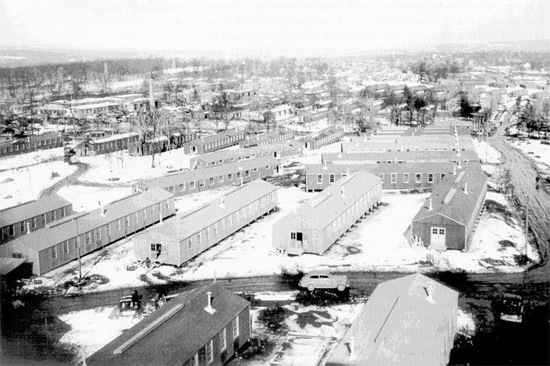
Partial aerial view of Camp Shanks, New York, which acted as a temporary staging area for the 635th Medical Clearing Company.
The unit left Fort Leonard Wood, Missouri by rail at 0700 hours on 9 January 1944, and rushed to Camp Shanks, New York, arriving there at 1450 hours the following day. Processing began immediately, and once completed temporary passes were issued to all personnel within the unit for New York City. The following day marked the beginning of an additional period of intense training and classroom activities.
On 16 January, a small advance party left the facility at Camp Shanks to make preparations for the unit’s trip overseas aboard SS “Empire Mace”. The balance of the unit departed Cp. Shanks by truck two days later, finally arriving at the New York Port of Embarkation at midday on 18 January. Embarkation began at 1530 hours and was completed several hours later. The American Red Cross had established numerous doughnut and coffee dispensaries around the port and harbor area, which made the experience somewhat more tolerable for all involved.
The ship set sail at 1200 hours on 19 January 1944. This was to be the 7,000-ton vessel’s first Atlantic crossing, but the ship was severely under-occupied (approximately 435 troops aboard, with a total capacity of around 1,100 personnel) which made for a comfortable crossing. The low occupancy also meant that hot meals were served three times a day, proving a real treat for all aboard.
During the crossing, life preservers were worn at all times, and it took the Company’s staff several days to find their sea legs. First Aid squads were also organized, largely using personnel from the Company, but no enemy activity was encountered during the crossing and no action was necessary. Chaplain Womble held services each evening, as well as two services on Sunday.
United Kingdom:
During the late evening of 29 January 1944, the ship made its way up the Firth of Clyde, and anchored. Two days were spent aboard the vessel until on 1 February the small landing boat finally came alongside its berth. The Company finally disembarked at Greenock, Scotland at 1645 on the same day. The personnel then proceeded to march under blackout conditions to its station, where it was greeted by the American Red Cross, offering warm coffee, doughnuts and a fully-stocked PX store.
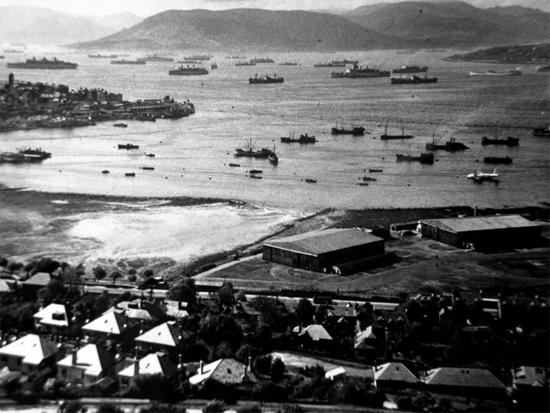
Partial aerial view showing numerous Army transport vessels in the Firth of Clyde, Scotland. Photograph taken in 1944.
At 0930 hours on 2 February 1944, the Company arrived at its new station in Stone, Staffordshire, where a billeting party from the 6th Convalescent Hospital received it and had waiting a hot meal and barrack facilities. The 635th was the first American unit to stay in Stone, occupying an old glass factory formerly used by British troops. Much work and ingenuity was required to bring the billets up to a liveable standard; Officers were quartered in pairs in private rooms, while the Enlisted Men were billeted inside 4 Nissen Huts. A small outbuilding was allotted for messing facilities. Once quartering had been completed, the Company was officially assigned to ETOUSA, and attached to the US VIII Corps. It would later be reassigned to the Third United States Army.
The Company was honored on 14 February 1944 by a visit from Major General Stanley Eric Reinhart (Commanding General of VIII Corps –ed). In addition, Col. Richard H. Eckhardt (Corps Surgeon, VIII Corps –ed) and his executive Lt. Col. Schedd were to be occasional visitors to the Company during its time in Staffordshire.
During the two months at Stone, the training schedule was continued with lectures emphasizing orientation and current events, aircraft recognition, and some of the more advanced medical subjects such as shock, oxygen therapy, intravenous therapy and immobilization of plaster casts, with practical application of the latter two. Physical conditioning was maintained by Capt. Kanner’s frequent “walks” and “runs” over the countryside with a definite emphasis on the latter, especially up hills. Arrangements were also made to use the athletic field at the neighboring Air Replacement Depot for regular soccer games between the Company and the 174th Medical Battalion.
Dances and frequent social events were organized by Lt. Johnson in his capacity as Special Services Officer. Trips to neighboring places of interest were also arranged, and regular passes were issued for visits to London, Birmingham, Oxford and Stratford-upon-Avon.
On 1 April 1944, the Company left Stone at 0830 by motor convoy and arrived at Widnes, Lancashire three hours later. The whole unit was billeted in private homes and Columba Hall was taken over for use as a mess hall and Company Headquarters.
The training program was continued and shortly after the arrival of Headquarters, 169th Medical Battalion, the Company was attached to it and relieved from attachment to 174th Med Bn. Besides the usual training and lectures, a field exercise was scheduled weekly, and on one occasion the station was set up and operated for the benefit of the Widnes Rotary Club. In early May, the Company received a favorable report following a TUSA IG inspection.
During the months from February to June, the Officers and a few Enlisted Men were able to take advantage of Army Technical Schools. Lieutenants Wheeler and Spencer attended the Plaster Technique School. Lt. Esterman, as Gas Officer, attended a school on decontamination and the treatment of gas casualties. Capt. Baker added to his duties as unit censor and became Booby Trap Officer after attending a course on the subject. Additional training lessons were also delivered in combat exhaustion, waterproofing of vehicles and surgical techniques.
Although the Company was alerted on 28 April 1944 for its “short sea voyage”, it was not until 14 June that the warning order finally arrived. On 20 June 1944 at 0745 hours the Company left Widnes; 64 Enlisted Men and 6 Officers traveled by train, with the balance of the unit traveling by motor convoy. They arrived in Dursley, Gloucestershire at 2000 hours, having covered a total distance of 168 miles. No sooner had the unit disembarked from its transport, that additional orders were received. The Company was now to proceed to the marshalling area at Hursley, Hampshire. The unit left Dursley two days later in the same split parties, and arrived at the new destination at 1230 hours on 23 June.

Portrait photograph of Captain David B. Johnson.
Courtesy Elaine A. Putvin.
In the marshalling area the waterproofing and administrative details were completed in the required 4 hours and the Company then settled back to wait, prepared to leave on a ½-hour notice. On 25 June the advance party of 6 Officers and 66 Enlisted Men left at 1212 hours by convoy. An LCI was docked in a small town near Southampton waiting to transport the Company to its new destination, Normandy, France.
France:
After spending two days aboard the LCI transport, the Company finally disembarked on Utah Beach at 0830 hours on the morning of 27 June 1944 (D+21 –ed). Ambulances from the 429th Medical Collecting Company had been sent to transport the unit’s personnel and equipment to a location 4 miles east of Sainte-Mère-Église.
On 27 June at 1125, the motor party left the marshalling area and arrived at Southampton at 1400. A night was spent on the docks in accommodations for the purpose. The following morning, the remainder of the unit boarded MT 212 and departed the docks at 0600. The convoy of LSTs and liberty ships assembled at the harbor’s mouth and under their balloon barrage set off for France. The voyage was smooth and uneventful and ended at sunset when the vessel dropped anchor near Utah Beach. The motor party remained aboard for the next two days, finally disembarking on the afternoon of 30 June, and joined the advance party later that evening.
At 1200 hours on 2 July, Second Platoon was in action, preparing to receive its first real patients since activation. First Platoon was held in reserve to be ready to move at any time. The site was an apple orchard between Sainte-Mère-Église and Pont-l’Abbé, in support of VIII Corps units in the area. Only minor cases were kept, those who could return to duty within 10 days. The other casualties were transferred to Evacuation Hospitals in the surrounding area. At this facility, the unit’s tents were arranged in the form of a cross, all being connected in the center. There was no attempt at camouflage and large red crosses were painted on all tents. Two additional very large red cross ground markers were displayed to guarantee aerial recognition of the facility.
First Platoon went into action on 12 July at 1500 hours. The Platoon was located 3 miles north of La Haye-du-Puits. On this date, Second Platoon went into reserve. The facility was similar to the set-up used by Second Platoon, and the assignment was the same except that at times, an overflow of slightly wounded patients was received from a Clearing Station of the 8th Infantry Division also in the area. This Infantry Division was later advancing further down the Cotentin peninsula, toward Brittany, with its elements even reaching as far as Rennes by 3 August 1944.
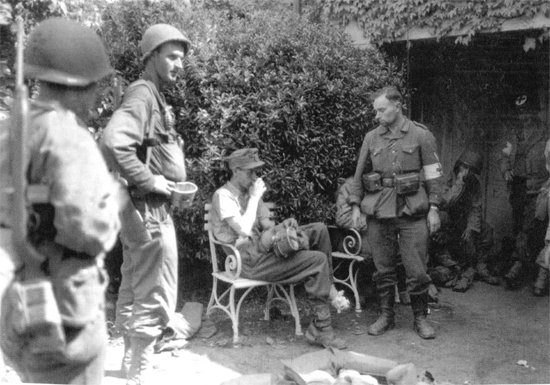
A captured German Medic works alongside his American counterparts to assist with the treatment of wounded troops from both nations at an Aid Station in Saint-Malo, France.
In the last week of July the breakthrough and the rapid advance down the western coast of Normandy began, which resulted in rapid leap-frogging of the two Platoons in an effort to keep up and continue to function efficiently. On 30 July Second Platoon was set up 2 miles east of Geffosses, and the following day First Platoon established a station outside of Hyenville.
On 8 August, First Platoon was set up 1 mile northeast of Plerguer in support of the operation at Saint-Malo. Here, the Officers and a small group of Enlisted Men from Second Platoon, along with a group of Enlisted Men from First Platoon were sent on detached service to the 53d Field Hospital which was in need of much assistance. During this period, numerous German prisoners were handled, having been evacuated from hospitals in the recently captured towns of Granville, Antrain, Saint-Brieuc, Guincamp and Morlaix.
The French natives in the region were very hospitable and swarmed to the station with bags filled with cider, wine and eggs, and left usually with the bags filled with various parts of K Rations, candy and cigarettes.
On 14 August, Second Platoon was sent on a separate mission in the vicinity of Nantes, and set up 1 mile south of Nezay. On 19 August, First Platoon moved to the vicinity of Saint-Méen-le-Grand, northwest of Brest. Second Platoon returned for a few days on 23 August and then on 30 August was sent to the vicinity of Samson to support the assault against the Mont Saint-Michel. On 4 September, the mission was completed, and so Second Platoon was once again transferred, this time to a new site near Lannilis, where it acted as a convalescent facility for patients received from the 108th Evacuation Hospital.
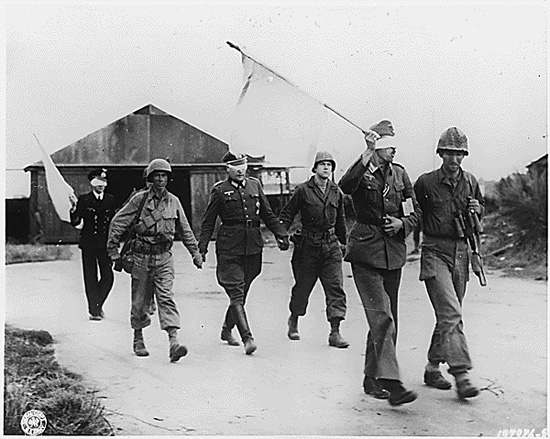
German prisoners are marched back to holding areas in Brest, France. Photograph taken September 1944.
The Company was officially relieved of its assignment to the Third U.S. Army and assigned to the Ninth U.S. Army on 5 September 1944. The ruins of Brest were captured on 19 September 1944 and two days later the remaining German soldiers in the Crozon Peninsula surrendered. Approximately 4,000 wounded Germans were left in US Army hospitals around Brest. The Company was assigned the task of evacuating two large underground hospitals and three smaller fortified hospitals containing approximately 1,500 casualties in total. As a result, most of the Company’s personnel had the opportunity to see the large German fortifications around the city, as well as the infamous submarine pens in the vicinity. The hospitals were tunnelled out of solid rock at the base of cliffs 150 to 200 feet high. There were entrances at the top and bottom. The wards were concrete or brick lined and were packed with patients. In each, there was a triple tier of bunks down each side and a double row down the center. Each ward contained about 100 wounded. Abundant medical and food supplies were found.
The unit continued to render medical assistance to the surrounding hospital units in the region until early October. Additional orders were received for the entire unit to transfer to Luxembourg in support of the Allied Forces advancing further into Germany.
Luxembourg:
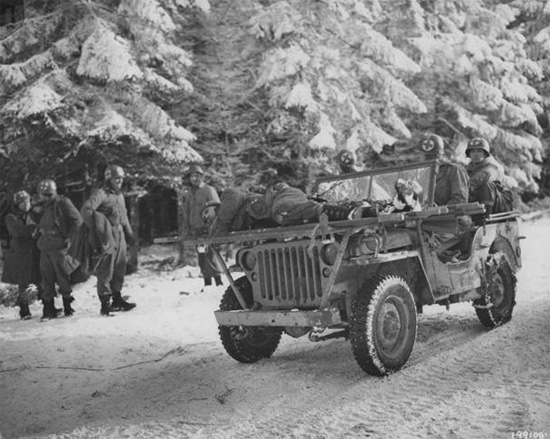
Medical personnel evacuate an injured US soldier on the hood of a Jeep somewhere in Luxembourg during the Battle of the Bulge.
The movement was completed by rail to Luxembourg during the second week of October 1944. The unit’s equipment arrived some days later, and the Company immediately began movement to its new location in Troisvierges. The area was a medical support concentration point with the 64th Medical Group and its units established at Cinqfontaines (Headquarters), Luxembourg (within easy travel distance of Bastogne, Belgium, where VIII Corps Headquarters was located –ed), with the 169th Medical Battalion (Separate) commanded by Lt. Colonel Steele and the 635th Medical Clearing Company established in the town proper. Upon arrival, the unit was attached to the 64th Medical Group, and the Commanding Officer was instructed to establish a Collecting Station in the main building of the Hotel Zum Bahnhof. The facility was officially opened on 9 October 1944 and the 635th was largely responsible for operating a Dispensary and other services for the 169th Medical Battalion.
The surrounding buildings at the railroad station on the western edge of town were equally occupied. The units operated a dispensary, and provided litter bearer, and ambulance services for rear echelon service troops located throughout the VIII Corps sector. The other units, attached to the 169th Medical Battalion provided similar services after October, with the 465th Medical Collecting Company operating at Nieder-Emmels, Belgium (near St. Vith) and the 429th Medical Collecting Company at Niederwampach, Luxembourg. During this time, both the 429thand465th Medical Collecting Companies were also assigned to duty with the 64th Medical Group.
By 15 December, it was realized that the support rendered by the 635th was no longer required, and VIII Corps orders instructed the unit to once again move to a new location in Belgium. During the period preceding the German counteroffensive in the Ardennes, the 64th Medical Group, was assigned three different Medical Battalions (all located and operating in Luxembourg):
169th Medical Battalion
429th Medical Collecting Company
465th Medical Collecting Company
635th Medical Clearing Company
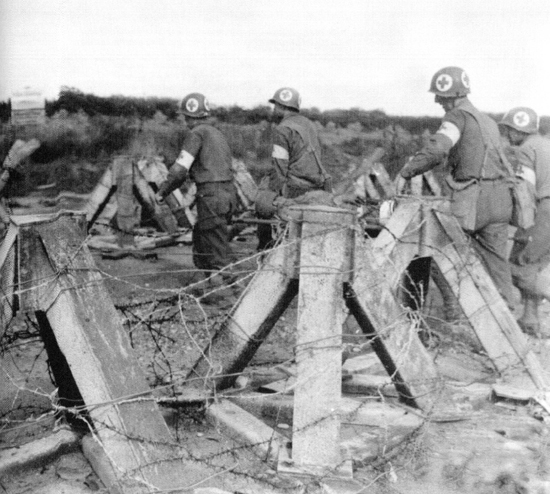
A group of 2d Infantry Division litter bearers from the 9th Infantry Regiment move past a German roadblock outside Brest, France.
170th Medical Battalion
590th Motor Ambulance Company
595th Motor Ambulance Company
623d Medical Clearing Company
240th Medical Battalion
580th Motor Ambulance Company
581st Motor Ambulance Company
419th Medical Collecting Company
Belgium:
The unit’s movement to Orval, Belgium was completed during the second week of December 1944. During the Company’s time at Orval, support was rendered to the 326th Airborne Medical Company (101st Airborne Division) with the 635th continuing to support the unit until the end of 1944. After the 326th Abn Med Co was overrun and captured by the Germans on 19 December, a number of patients were evacuated by a Platoon of the 429th Medical Collecting Company and transported to the 635th who provided them with the necessary care and comfort. They were fortunate, for by 2330 hours, 20 December 1944, the enemy had succeeded in cutting the Bastogne-Neufchâteau road, the last route of evacuation to the rear. On 1 January 1945, the 635th was located at a new site approximately 1 mile south of Longlier, Belgium, where it continued to provide litter and clearing services to the 101st Airborne.
Roster (incomplete):
| Officers: | |
| Baker, Henry F. (Lt) | O’Connor, William J. (Lt) |
| Cheron, Abraham J. (Lt) | Peterson, William H (Capt) |
| Footerman, Louis M. (Lt) | Sperber, Thomas J. (Lt) |
| Gibson, Norman T. (Capt) | Wheeler, Edward M. (Lt) |
| Johnson, David B. (Capt) | Womble, John W. (Capt, Chaplain) |
| Kanner, Morris (Capt, C/O) | Zimmer, William (Capt) |
| Mulligan, John J. (Lt) |

Separation papers belonging to Captain David B. Johnson (ASN:O-352059) who served with the 635th Medical Clearing Company during WW2.
Courtesy Elaine A. Putvin.
| Enlisted Men: | |
| Boggess (Tec 5) | Nikelevic, Anthony T. (S/Sgt) |
| Caddick (Sgt) | Peterson (Tec 3) |
| Faeth (S/Sgt) | Prochera (Tec 3) |
| Fuller (Tec 4) | Rokely (Sgt) |
| Handshaw (Sgt) | Scheil, Peter G. (Sgt) |
| Huberts (S/Sgt) | Wiliford (Cpl) |
| Male, Vander (Tec 5, Chap. Asst.) | Woods (Tec 4) |
An amended T/O & E 8-28 dated 4 September 1944 was published by the War Department and included the following changes:
Commissioned Officers – 13 andEnlisted Men – 99.
Vehicles – 3 ¼-ton trucks, 1 ¾-ton weapons carrier, 2 1½-ton cargo trucks, 4 2½-ton cargo trucks, 2 ½-ton cargo trucks (w/ winch), 1 ¼-ton trailer, 6 1-ton cargo trailers, 2 1-ton 250-gallon water tank trailers.
The MRC staff will be forever indebted to Elaine A. Putvin, daughter of Captain David B. Johnson (ASN:O-352059) who served with the 635th Medical Clearing Company during WW2. Elaine kindly provided us with numerous original documents and reports which have allowed the editing of this Unit History. The authors are still looking for additional information relating to the unit’s service in 1945, and in particular its return to the ZI and eventual inactivation.
